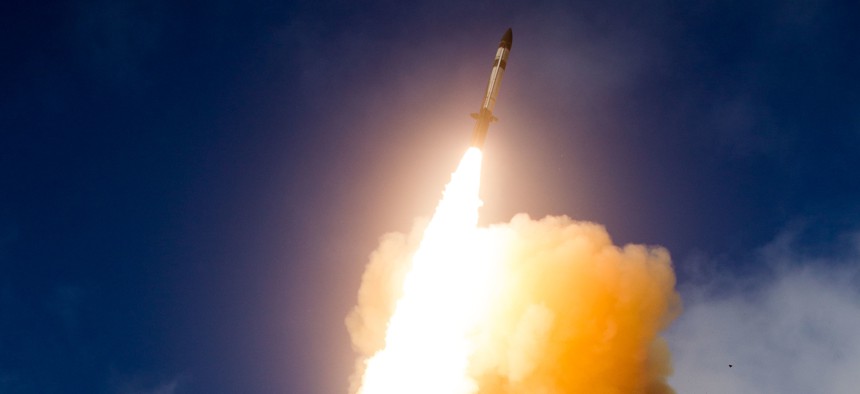
An SM-3 Block IIA during a 2015 flight test. DoD photo by Ralph Scott
In First, Navy Ship Shoots Down ICBM with SM-3 Interceptor
The test could set the stage for a new framework of missile interceptors in the Pacific.
A U.S. Navy destroyer shot down an unarmed intercontinental ballistic missile near Hawaii Monday using an SM-3 interceptor — a significant step toward a new capability to down enemy missiles lobbed from thousands of miles away.
The intercept marks the first time the Raytheon-made SM-3 has shot down an ICBM — an accomplishment, officials and experts say, that improves the security of the U.S. and allies and could set the stage for deploying the interceptors to defend Hawaii and Guam from North Korean or Chinese missiles.
“Think about this as the ticket for regional missile defense, for our forward forces, for the fleet, and for Guam,” Thomas Karako, a missile defense expert with the Center for Strategic and International Studies, said Tuesday. “That's going to be absolutely central and critical for the future war plan that's being developed for China.”
Others have argued that adding missile defenses is a classic security dilemma: because offensive missiles are cheaper than reliable defenses, adversaries are incentivized to build up their arsenals.
In Monday’s test, the interceptor was launched from the guided missile destroyer John Finn, which is equipped with the AEGIS Ballistic Missile Defense System. It shot down a mock ICBM simulating a strike on Hawaii, Missile Defense Agency officials said.
“It's more of a confirmation that we have a little bit of operational flexibility and we have options,” Karako said.
Pentagon officials are considering using the AEGIS missile defense system to augment land-based missile interceptors in Alaska and California, “by fielding additional sensors and weapon systems to hedge against unexpected developments in the missile threat,” Vice Adm. Jon Hill, the Missile Defense Agency director, said in a statement. Monday’s successful test “is a step in the process of determining its feasibility as part of an architecture for layered defense of the homeland,” Hill said.
The Pentagon has been beefing up its missile defenses amid Chinese, Russian, North Korean and Iranian missile development.
The United States is guarded from North Korean and Iranian missiles by Ground-Based Midcourse Defense, the interceptors based in Alaska and California. Those missiles, based in underground silos in Alaska and California, are much larger and faster than the SM-3, which is built to launch from tubes in a ship.
The SM-3 Block IIA has larger rocket motors than older versions of the missile, allowing it to “defend broader areas from ballistic missile threats,” according to Raytheon. It interceptor also has a larger kinetic warhead, which “has been enhanced, improving the search, discrimination, acquisition and tracking functions, to address advanced and emerging threats.”
The U.S. has been co-developing the SM-3 Block IIA interceptor with Japan, which had planned to build an AEGIS Ashore missile defense site, but suspended the project in June due to its high cost and technical problems. The missile had a spotty test record, before recent achievements.
Military leaders have been pushing for an AEGIS Ashore missile defense site in Guam, similar one in Romania and another under construction in Poland. Guam is home to Air Force, Navy and Marine Corps bases and is considered an important piece of military operations in the Pacific.
“We're going to want to have a robust and yes, thick, defense of Guam against both ballistic and cruise missiles and hypersonic [weapons] as well,” Karako said.
The Pentagon is also soliciting bids for a new Next-Generation Interceptor that would play a key role in protecting the United States from long-range ballistic missiles.
This week’s successful SM-3 test “buys time for [the Next-Generation Interceptor], to get here,” Karako said.




